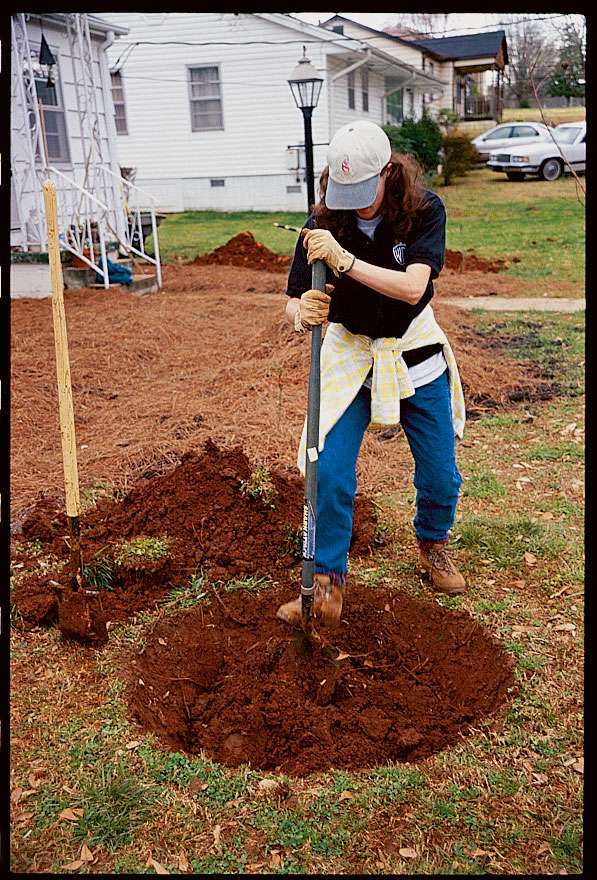Written by Jasper Boekelman and published on https://www.southernliving.com/
After you have researched and selected the best tree to plant in your yard, it’s time to get it in the ground. Digging the right-size planting hole is the key to getting your new tree off to a good start, but there are a few other factors in play, too, such as timing. Fall is the best time to do your digging. That’s because hot summer temperatures can stress new plants, especially if they don’t get much rain, so planting in autumn gives them a little extra time to establish themselves before warm weather arrives again the following year. Adding a new tree to your yard can add beauty and value to your home so use these tips to get planting.
Tree Planting 101

When planting a tree, always dig a hole as deep as the tree’s root ball and twice as wide.
Planted correctly, trees can enhance the look of your yard, benefiting it for generations to come. Trees add an upright element to the landscape and help soften the lines of a house.
When selecting trees, always consider the space you have to fill, and think about a tree’s mature size. This will help determine if you need a small, medium, or large tree (see information below). Take into consideration any overhead lines, and make sure plants won’t eventually interfere with them.
Before digging any large holes, take time to contact your local utility companies to mark gas lines, water pipes, or underground cables.
Once you select the perfect tree and site, dig a hole as deep as the tree’s root ball and twice as wide. A mattock and round-point shovel are essential for planting, and an ax comes in handy if the hole has lots of roots. Mix organic matter, such as sphagnum peat moss or soil conditioner, with the excavated soil.
Gently set the tree into the hole, placing the top of the root ball a couple of inches higher than the ground. If your tree was container-grown and the roots are matted together, use a pocketknife to loosen the roots.
Shovel half the amended backfill in the hole until the tree stands upright on its own. Step away, and make sure it’s straight with the best side facing forward. Make any adjustments before shoveling in the remaining backfill. While filling, occasionally stop to pack the soil down against the root ball with your foot.
Using your hands, shape loose soil into a circular mound around the tree. The bowl shape helps pool water, which trickles down onto the roots with minimal runoff. After planting, water thoroughly, allowing a hose to slowly drip at the tree’s base for an hour or two. For the first few weeks, new trees need several soakings.
The ideal time to plant a tree is in the late fall or winter when they’re dormant, but they can be planted any time. If temperatures are high and trees are actively growing, they require much more water and care.
New trees benefit from 3 or 4 inches of mulch to keep moisture in. Rings of mulch also provide a buffer to keep string trimmers away from the trunks.
Plant a tree correctly, and it will flourish. Besides being aesthetically pleasing, trees are sure to increase your property value.
Trees for Your Yard
SMALL
- Japanese maple (Acer palmatum)–25 ft. tall, delicate foliage, nice fall color
- flowering dogwood (Cornus florida)-25 ft. tall, white blooms, fall color
- crepe myrtle (Lagerstroemia indica)-varies in size depending on selection, 3 to 35 ft. tall; summer bloom, many different colors
- fringe tree (Chionanthus virginicus)-20 to 30 ft. tall, late spring bloom, white thread-like petals
- Eastern redbud (Cercis canadensis)-25 to 30 ft. tall, early spring pink or white blooms depending on selection
MEDIUM
- red or sugar maple (Acer rubrum or A. saccharinum)-40 to 60 ft. tall, excellent fall color
- ‘Little Gem’ magnolia (Magnolia grandiflora ‘Little Gem’)-30 to 40 ft. tall, white summer blooms, evergreen
- Chinese pistache (Pistacia chinensis)-30 to 40-ft. tall, good fall color
- Chinese elm (Ulmus parviflora)-40 to 60 ft. tall, beautiful shedding bark, nice shade tree
LARGE
- tulip poplar (Liriodendron tulipifera)-80 ft. tall, fast growing, nice fall color
- Southern magnolia (Magnolia grandiflora)-80 ft. tall, evergreen, fragrant summer flowers
- Canadian hemlock (Tsuga canadensis)-50 to 70 ft. tall,evergreen with small soft needles
- pin, live, and willow oak (Quercus sp.)-60 to 80 ft. tall, pin and willow are deciduous, live oak is evergreen. All are nice stately shade trees.
Original post here https://www.southernliving.com/home-garden/gardens/tree-planting/.